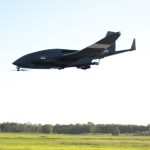By Raeleigh Jones
In February, 2014, Sheikh Mohammed Bin Rashid Al Maktoum, Vice President and Prime Minister of the UAE and Ruler of Dubai launched the United Arab Emirates “Drones for Good” award. In speaking of the purpose for the award, he said, “We want to reach to people before they reach us. We want to save time, to shorten distances, to increase effectiveness and to make services easier. In the international competition, one million US dollars are awarded for the best use of civilian drones for improving people’s lives. In 2014, Flyability won the international prize with their drone, ‘GimBall.'”
The GimBall is the culmination of three years of research and development. It is a small, lightweight drone that will primarily be used in search and rescue. It is just larger than a basketball, runs on batteries, and is driven and steered with two propellers and fins. The description of the design on the Drones for Good web page is as follows:
Flyability’s GimBall has the unusual ability to squeeze into tight indoor spaces and search for potential disaster victims, thanks to its geodesic design. The entire UAV is effectively a two-prop, electronically stabilized gimbal surrounded by a tough, lightweight carbon-fiber cage. Instead of trying to pull off the daunting task of avoiding obstacles, the GimBall can just plough right into them, bounce off and then carry on to its destination.
This design uses the same mechanics as camera systems that allow fluid filming without showing the hand movements of the person filming, so that collisions do not bother the design. In addition, the innovative design protects itself and protects humans from the propellers inside. The GimBall doesn’t need complex sensors or piloting to avoid collisions, which makes it more user friendly. Patrick Thevoz, co-founder of Flyability, discussed their design in an interview with Droneblog. What makes the Gimball’s design so unique, he says, is their mechanical solution to the problem of running into obstacles, which most companies and researchers have tried to solve through sensors and digital solutions. The inspiration comes from insect flight patterns, and their unique ability to continue flying after collision. After a collision, the robot does not “feel” the collision; it can remain stable, continue on its path, and continue filming without disturbance. In fact, the obstacles serve as guides rather than hindrances for the GimBall.
The biggest challenge the team faced in development was balancing the weight of the robot to handle the forces and collisions. To address this issue, they used advanced materials like carbon fiber to make the GimBall lightweight and robust. At the same time, the company is looking for ways to minimize the cost of the GimBall while using these advanced materials so that the technology can be mass-produced. Thevoz estimates that the current price point for a professional-use GimBall, with the expensive sensors and equipment needed for inspections would run between 20,000 and 50,000 dollars. However, the mass-produced toy versions of the product would be significantly cheaper so as to be accessible for the general public.
Flyability envisions search and rescue, industrial inspection, and the oil and gas industry as main targets for their design. Inspection and search and rescue using the GimBall is time efficient, and requires only the drone as equipment, saving money and transportation costs for other larger equipment that would be needed to perform the same inspection. On the other side of the market, the GimBall has application in entertainment. The crash-proof, lightweight design appeals to the user as a fun, playful, and safe technology.
Flyability didn’t expect to win the Drones for Good competition. When they heard about the competition, they submitted an application with the attitude of “we might as well try.” As time progressed, their application was accepted and they continued through the semi-finals of the competition until they pitched their idea to the royal family of the United Arab Emirates. Thevoz shared his feelings on the stress leading to the finals and actually winning the award in the Droneblog interview, “having the opportunity to pitch for a million dollars is not something that happens a lot in a lifetime, so there was lots of stress… you always dream about winning the lottery and try to guess how you would react… and even when it happens to you, you still don’t know how to react.” He said that the company is now facing an unending flow of requests to purchase their product and to join their team. They have had an overwhelming outpouring of support since winning the competition, and they are taking every opportunity to share their vision of what drones can become in the future.
In the same interview, Thevoz said that a major goal for the project is to improve the public reputation of drones, which has been generally negative in the past. The recent publicity and success Flyability is enjoying is giving them the opportunity to do just that.
With the 1 million dollar prize from Drones for Good, Flyability is ready to fully move forward in development and production of the robot. They are confident moving forward with the right offices, employees, and investors. The prize money will enable them to focus on the technical challenges they face, and their goal is to make their dream a reality by transforming the GimBall from a prototype to a real product by the end of this year.
Flyability envisions a world in which drones are not seen as mindless killing machines, but as helpful resources and tools. They hope for a day when their technology will assist in saving, improving, and brightening lives through inspection, search and rescue, and fun.



